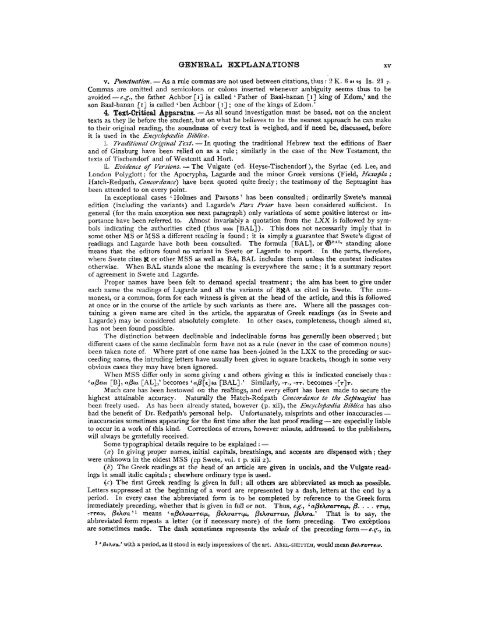cheenc03a.pdf
cheenc03a.pdf
cheenc03a.pdf
You also want an ePaper? Increase the reach of your titles
YUMPU automatically turns print PDFs into web optimized ePapers that Google loves.
QENERAL EXPLANATIONS<br />
xv<br />
v. Puncltlatim. -As a rule commas are not used between citations, thus: ? K. 6 11 3s Is. 21 7.<br />
Commas are omitted and semicolons or colons inserted whenever ambiguity seems thus to be<br />
avoided-e.g., the father Achbor [I] is called 'Father of Baal-hanan [I] king of Edom,' and the<br />
son Baal-hanan [I] is called 'ben Achbor [I] ; one of the kings of Edom.'<br />
4. Text-Critical Apparatus. - As all sound investigation must be based, not on the ancient<br />
texts as they lie before the student, but on what he believes to be the nearest approach he can make<br />
to their original reading, the soundness of every text is weighed, and if need be, discussed, before<br />
it is used in the Encyclo#edin Biblica.<br />
i. Traditimnl Or@al Text. -In quoting the traditional Hebrew text the editions of Baer<br />
and of Ginsburg have been relied on as a rule; similarly in the case of the New Testament, the<br />
texts of Tischendorf and of Westcott and Hort.<br />
ii. Evidence of Versions. -The Vulgate (ed. Heyse-Tischendorf), the Syriac (ed. Lee, and<br />
London Polyglott; for the Apocrypha, Lagarde and the minor Greek versions (Field, Hexajla ;<br />
Hatch-Redpath, Concordance) have been quoted quite freely; the testimony of the Septuagint has<br />
been attended to on every point.<br />
In exceptional cases 'Hollnes and Parsons' has been consulted; ordinarily Swete's manual<br />
edition (including the variants) and Lagarde's Parr Prim have been considered sufficient. In<br />
general (for the main exception see next pangraph) only variations of some positive interest or importance<br />
have been referred to. Almost invariably a quotation from the LXX is followed by symbols<br />
indicating the authorities cited (thus "cot [UAL]). This does not necessarily imply that in<br />
some other IMS or MSS a different reading is found: it is simply a guarantee that Swete's digest of<br />
~eadings and Lagarde have bath been consulted. The formula [BAL], or @"". standing alone<br />
means that the editors found no variant in Swete or Lagarde to report. In the parts, therefore,<br />
where Swete cites S or other MSS as well as BA, BAL includes them unless the context indicates<br />
otherwise. When BAL stands alone the meaning is everywhere the same; it is a summary report<br />
of agreement in Swete and I.agarde.<br />
Proper names have been felt to demand special treatment; the aim has been to give under<br />
each name the readings of Lagarde and all the variants of BXA as cited in Swete. The commonest,<br />
or a common, form for each witness is given at the head of the article, and this is followed<br />
at once or in the course of the article by such variants as there are. Where all the passages containing<br />
a given name are cited in the article, the apparatus of Greek readings (as in Swete and<br />
Lagarde) may be considered absolutely complete. In other cases, completeness, though aimed at,<br />
bas not been found possible.<br />
The distinction between declinable and indeclinable forms has generally been observed; but<br />
different cases of the same declinable form have not as a rule (never in the case of common nouns)<br />
been taken note of. Where part of one name has been .joined in the LXX to the preceding or succeeding<br />
name, the intruding letters have usually been given in square brackets, though in some very<br />
obvious cases they may have been ignored.<br />
When MSS differ only in some giving rand others giving rr this is indicated concisely thus:<br />
'a/3e~a[B], m/3m [AL],' becomes 'ap[;Jm [BAL].' Similarly, -7..-rr. becomes -[r]r.<br />
Much care has been bestowed on the reaaings, and every effort has been made to secure the<br />
highest attainable accuracy. Naturally the Hatch-Redpath Concordance to the Septuagint has<br />
been freely used. As has been already stated, however (p. xii), the Encyclopedia Bibliia has also<br />
had the benefit of Dr. Redpath's personal help. Unfortunately, misprints and other inaccuraciesinaccuracies<br />
sometimes appea"ng for the first time after the last proof reading- are especially liable<br />
to occur in a work of this kind. Corrections of errors, however minute, addressed. to the publishers,<br />
will always be gratefully received.<br />
Some typographical details require to be explained: -<br />
(a) In giving proper names, initial capitals, breathings, and accents are dispensed with; they<br />
were unknown in the oldest MSS (cp Swete, vol. r p. xiii 2).<br />
(6) The Greek readings at the head of an article are given in uncials, ahd the Vulgate readings<br />
in small italic capitals; elsewhere ordinary type is used.<br />
(6) The first Greek reading is given in full; all others are abbreviated as much as possible.<br />
Letters suppressed at the beginning of a word are represented by a dash, letters at the end by a<br />
period. In every case the abbreviated form is to be completed by reference to the Greek form<br />
immediately preceding, whether that is given in full or not. Thus, e.g., 'aprhm~cr~ p. .. . rr'p.,<br />
-rrnv, prAua" means 'aprAoarrrrp, /3rAuarr~p, prhca~rrrv, /3doa.' That is to say, the<br />
abbreviated form repeats a letter (or if necessary more) of the form preceding. Two exGptions<br />
are sometimes made. The dash sometimes represents the whole of the preceding form-r.~., in<br />
'Bthca.'with aperiod,as it stood in early impressions of the art. ABEL-SHITTIM, wouldmean Behrarrr~r.
















